Top 10 Casting Process Characteristics Summary
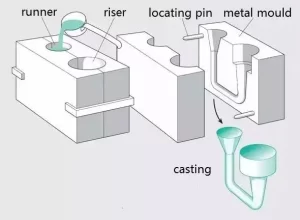
The production method of pouring liquid metal into a mold cavity that is suitable for the shape and size of the part, and waiting for it to cool and solidify to obtain a blank or part, is usually called metal liquid forming or casting.
Process flow: liquid metal → filling → solidification shrinkage → casting part
Process characteristics:
- It can produce parts with any complex shape, especially those with complex inner cavity shapes.
- Strong adaptability, unrestricted alloy types, and almost unlimited casting size.
- The material source is wide, the waste can be remelted, and the equipment investment is low.
- High scrap rate, low surface quality, and poor working conditions.
Casting classification:
(1) Sand casting
Sand casting: A casting method for producing castings in sand molds. Steel, iron, and most non-ferrous alloy castings can be obtained by sand casting method.
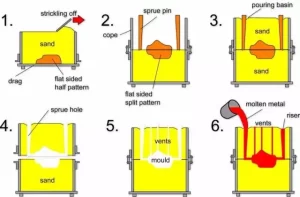
Technical features:
- Suitable for making blanks with complex shapes, especially those with complex inner cavities;
- Wide adaptability and low cost;
- For certain materials with poor plasticity, such as cast iron, sand casting is the only forming process for manufacturing their parts or blanks.
Application: Castings for automotive engine cylinder blocks, cylinder heads, crankshafts, etc
(2) Investment casting
Investment casting also called lost wax casting, which is a time-honored manufacturing process that involves pouring molten metal into a ceramic mold. To create the mold, a disposable wax pattern is first made in the shape of the desired part. This pattern is then surrounded, or “invested,” in ceramic slurry, which hardens to form the mold.
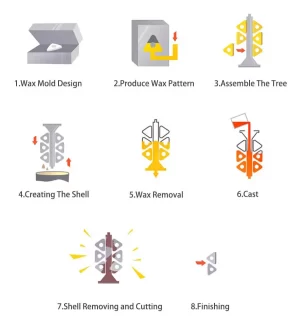
Process characteristics
Advantages:
- High dimensional and geometric accuracy;
- High surface roughness;
- Capable of casting castings with complex shapes and unrestricted casting alloys.
Disadvantages: Complex processes and high costs
Application: Suitable for producing small parts with complex shapes, high precision requirements, or difficulty in other processing, such as turbine engine blades.
(3) Die casting
Die casting: It is the use of high pressure to rapidly press molten metal into the cavity of a precision metal mold, and the molten metal cools and solidifies under pressure to form a casting.
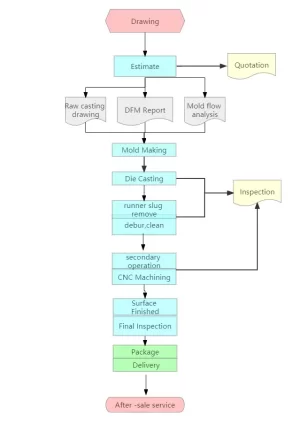
Process characteristics
Advantages:
- During die casting, the metal liquid bears high pressure and has a fast flow rate
- Good product quality, stable size, and good interchangeability;
- High production efficiency and frequent use of die-casting molds;
- Suitable for large-scale production with good economic benefits.
Disadvantages:
- Castings are prone to producing small pores and shrinkage porosity.
- Die castings have low plasticity and are not suitable for working under impact loads and vibrations;
- When high melting point alloys are die-casting, the mold life is low, which affects the expansion of die-casting production.
(4) Low pressure casting
Low pressure casting: refers to the method of filling the mold with liquid metal under lower pressure (0.02-0.06 MPa) and crystallizing under pressure to form a casting.
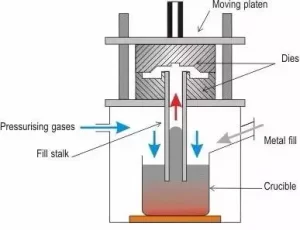
Technical features:
- The pressure and speed during pouring can be adjusted, making it suitable for various different casting molds (such as metal molds, sand molds, etc.), casting various alloys and castings of various sizes;
- Adopting bottom injection molding, the metal liquid filling is smooth and free of splashing, which can avoid gas entrapment and erosion of the mold wall and core, and improve the qualification rate of castings;
- Castings crystallize under pressure, with a dense microstructure, clear contours, smooth surface, and high mechanical properties, making them particularly advantageous for casting large and thin-walled parts;
- Eliminating the need for shrinkage risers, the metal utilization rate is increased to 90-98%;
- Low labor intensity, good working conditions, simple equipment, and easy implementation of mechanization and automation.
Application: Mainly based on traditional products (cylinder head, wheel hub, cylinder frame, etc.).
(5) Centrifugal casting
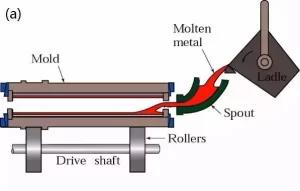
Process characteristics
Advantages:
- There is almost no metal consumption in the pouring system and riser system, improving the process yield;
- When producing hollow castings, the core is not needed, so the metal filling capacity can be greatly improved when producing long tubular castings;
- Castings have high density, fewer defects such as pores and slag inclusions, and high mechanical properties;
- Easy to manufacture composite metal castings for cylinders and sleeves.
Disadvantages:
- There are certain limitations when using it to produce special-shaped castings;
- The diameter of the inner hole in the casting is inaccurate, the surface of the inner hole is relatively rough, the quality is poor, and there is a large machining allowance;
- Castings are prone to specific gravity segregation.
Application:
Centrifugal casting was first used in the production of cast pipes, and it is widely used in industries such as metallurgy, mining, transportation, drainage and irrigation machinery, aviation, national defense, and automobiles both domestically and internationally to produce steel, iron, and non-ferrous carbon alloy castings. The production of castings such as centrifugal cast iron pipes, internal combustion engine cylinder liners, and shaft sleeves is particularly common.
(6) Gravity die casting
Gravity die casting: refers to a molding method in which liquid metal is filled into a metal mold under the action of gravity and cooled and solidified in the mold to obtain a casting.
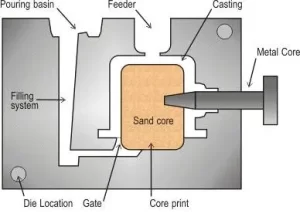
Process characteristics
Advantages:
- The thermal conductivity and heat capacity of metal molds are high, the cooling speed is fast, the casting structure is dense, and the mechanical properties are about 15% higher than sand mold castings.
- Castings that can achieve high dimensional accuracy and low surface roughness values, and have good quality stability.
- By not using or rarely using sand cores, the environment is improved, dust and harmful gases are reduced, and labor intensity is reduced.
Disadvantages:
- The metal mold itself has no breathability, and certain measures must be taken to export the air in the mold cavity and the gas generated by the sand core;
- Metal molds have no yielding properties and are prone to cracking during casting solidification;
- The manufacturing cycle of gravity die casting is long and the cost is high. Therefore, only in mass production can good economic results be demonstrated.
Application: Gravity die casting is suitable for mass production of non ferrous alloy castings such as aluminum alloys and magnesium alloys with complex shapes, as well as for the production of castings, ingots, and other steel metals.
(7) Vacuum die casting
Vacuum casting: an advanced die-casting process that eliminates or significantly reduces porosity and dissolved gases in the die-casting mold cavity during the die-casting process, thereby improving the mechanical properties and surface quality of the die-casting parts.
Process flow:
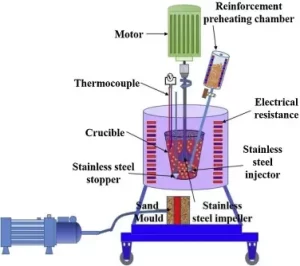
Advantages:
- Eliminate or reduce internal porosity in die castings, improve mechanical properties and surface quality of die castings, and improve coating performance;
- Reducing the back pressure of the mold cavity can use alloys with lower specific pressure and poorer casting performance, and it is possible to use small machines to cast larger castings;
- Improved filling conditions, capable of die-casting thinner castings;
Disadvantages:
- The sealing structure of the mold is complex, making it difficult to manufacture and install, resulting in higher costs;
- If the vacuum die-casting method is not controlled properly, the effect will not be very significant.
(8) Squeezing die casting
Pressure relief, mold separation, blank demolding, and resetting;
Indirect squeeze casting: coating spraying, mold closing, feeding, mold filling, pressurization, pressure holding, pressure relief, mold separation, blank demolding, and resetting.
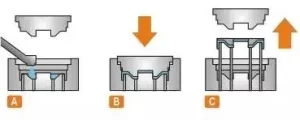
Technical features:
- Can eliminate internal defects such as porosity, shrinkage, and porosity;
- Low surface roughness and high dimensional accuracy;
- Can prevent the occurrence of casting cracks;
- Easy to achieve mechanization and automation.
Application: Can be used to produce various types of alloys, such as aluminum alloys, zinc alloys, copper alloys, ductile iron, etc
(9) Lost foam casting
Lost foam casting (also known as full mold casting): It is a new casting method that combines paraffin or foam models similar to the size and shape of the castings into model clusters, brushes and dries refractory coatings, buries them in dry quartz sand for vibration molding, pours them under negative pressure, vaporizes the models, occupies the mold position with liquid metal, and forms castings after solidification and cooling.
Process flow: foaming pattern → Clustering → coating immersion → drying → Compaction → Casting→ sand cleaning
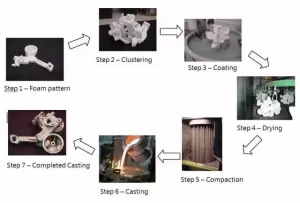
Technical features:
- High casting accuracy, no sand core, reduces processing time;
- No parting surface, flexible design, high degree of freedom;
- Clean production, pollution-free;
- Reduce investment and production costs.
Application: Suitable for producing various sizes of precision castings with complex structures, with unlimited alloy types and production batches. Such as gray cast iron engine casing, high manganese steel bend pipes, etc.
(10) Continuous casting
Continuous casting: It is an advanced casting method that continuously pours molten metal into a special metal mold called a crystallizer. The solidified (crust) casting is continuously pulled out from the other end of the crystallizer, and it can obtain castings of any length or specific length.
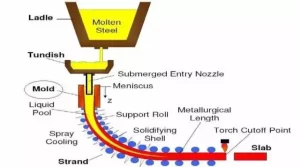
Technical features:
- Due to the rapid cooling of the metal, the crystal is dense, the structure is uniform, and the mechanical properties are good;
- Save metals and improve yield;
- Simplified the process, eliminating the need for styling and other procedures, thus reducing labor intensity; The required production area has also been significantly reduced;
- Continuous casting production is easy to achieve mechanization and automation, improving production efficiency.
Application: Continuous casting can be used to cast long castings with unchanged cross-sectional shapes, such as ingots, slabs, bars, pipes, etc., such as steel, iron, copper alloys, aluminum alloys, magnesium alloys, etc.
Disclaimer: Some of the content in this article is reproduced online, and the copyright belongs to the original author. If there are any copyright issues related to the work, please contact us. We will confirm the copyright based on the copyright proof materials you provide and delete or take relevant measures within one week of receiving the proof!
